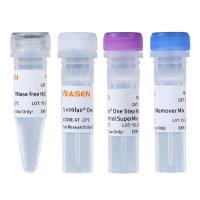Restriction Endonuclease Digestion of DNA
The ability to cleave DNA at specific sites is one of the cornerstones of today’s methods of DNA manipulation. Restriction endonucleases are bacterial enzymes that cleave duplex DNA at specific target sequences with the production of defined fragments. These enzymes can be purchased from the many manufacturers of biotechnology products. The nomenclature of enzymes is based on a simple system, proposed by Smith and Nathans (1 ). The name of the enzyme (such as Bam HI, Eco RI, and so on) tells us about the origin of the enzyme but does not give us any information about the specificity of cleavage (see Note 1 ). This has to be determined for each individual enzyme. The recognition site for most of the commonly used enzymes is a short palindromic sequence, usually either 4, 5, or 6 bp in length, such as AGCT (for Alu I), GAATTC (for Eco RI), and so on. Each enzyme cuts the palindrome at a particular site, and two different enzymes may have the same recognition sequence but cleave the DNA at different points within that sequence. The cleavage sites fall into three different categories, either flush (or blunt) in which the recognition site is cut in the middle, or with either 5′- or 3′-overhangs, in which case unpaired bases will be produced on both ends of the fragment. For a comprehensive review of restriction endonucleases, see Fuchs and Blakesley (2 ).
![预览]()






